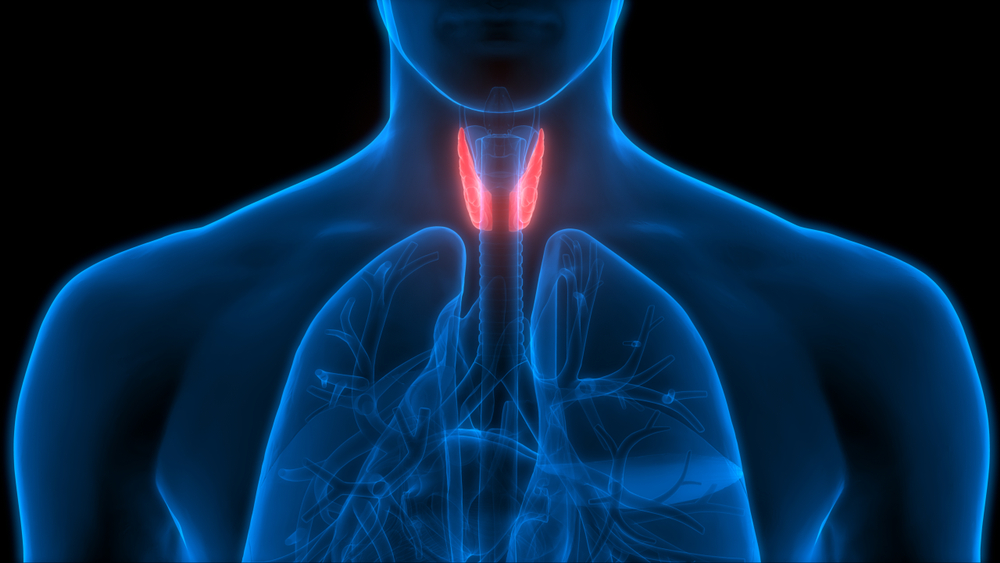Act quickly to address this potentially fatal condition.
Takeaways:
- Thyroid storm is a life-threatening condition that’s associated with a high rate of mortality due to its effects on all organ systems.
- Rapid recognition and early treatment of symptoms and precipitating factors of thyroid storm are critical in minimizing potential complications.
Your patient, Barbara Dulaney*, was admitted last night to the progressive care unit for right lower lobe pneumonia. She’s 51 years old, smokes two packs of cigarettes per day, and was diagnosed with Graves’ disease 10 years ago. Her treatment includes I.V. fluids, antibiotic therapy, albuterol via nebulizer, acetaminophen as needed for fever and pain, and benzonatate as needed for cough.
When you enter the room, Mrs. Dulaney tells you she’s feeling anxious and having heart palpitations. She’s restless and has trouble lying still during your assessment, which reveals diaphoresis, tachycardia, rales in the lower lobe of the right lung, exophthalmos, goiter, and hand tremors. Her vital signs are heart rate 138 BPM, temperature 101.9° F (38.8° C), BP 164/98 mmHg, and oxygen saturation 94% on 2 liters of oxygen per minute via nasal cannula. On a scale of 0 to 10, Mrs. Dulaney reports chest pain at 6 and abdominal pain at 8. She also says she’s had nausea for the past 2 hours. You call the hospitalist and administer acetaminophen for fever and pain per protocol.
On the scene
Results from tests ordered by the hospitalist are: chest X-ray shows no cardiac enlargement or pulmonary edema; ECG shows sinus tachycardia; and laboratory tests indicate troponin I within normal limits, mild leukocytosis, elevated T3 and T4, decreased thyroid–stimulating hormone levels, and mildly elevated aspartate aminotransferase and alanine aminotransferase levels. As a result, cardiac injury is ruled out, and Mrs. Dulaney is diagnosed with thyroid storm.
Your immediate priorities are to decrease Mrs. Dulaney’s heart rate and body temperature and to prevent vascular collapse. You place a cooling blanket over her, decrease the room temperature, and provide I.V. fluids at 100 mL/hr. You administer ordered medications: methimazole (antithyroid), dexamethasone (glucocorticoid), and propranolol (beta blocker). The patient’s pneumonia, likely the thyroid storm’s precipitating factor, will continue to be treated with I.V. antibiotics. To help manage Mrs. Dulaney’s anxiety, you provide a calm environment by dimming the lights and providing reassurance.
Outcome
Mrs. Dulaney is transferred to the ICU to be montiored for potential complications, including heart failure, cardiac arrythmias, neurovascular decline, and shock. She is given iodine therapy after the methimazole to inhibit further release of thyroid hormone. Her serum hormone levels may take up to a week to decrease to baseline. After hospital discharge, Mrs. Dulaney will need to follow up with her endocrinologist for medication management and likely radioactive iodine therapy, to destroy the thyroid gland, or thyroidectomy, for permanent hyperthyroid treatment.
Education
Hyperthyroidism from Graves’ disease is routinely treated with antithyroid medications and beta blockers. However, factors such as infection, stress, sudden cessation of antithryroid medicine, and trauma can increase serum thyroid hormone levels, potentially leading to thyroid storm, which has a high mortality rate and warrents agressive treatment.
Excessive thyroid hormone affects all organ systems, including cardiac, neurovascular, and GI. Initial thyroid storm symptoms may go unnoticed, especially in the presence of illness such as pneumonia, so early recognition is critical. Nursing education for patients with hyperthyroidism should include medication adherence, signs of increased thyroid hormone levels, and when to seek medical help.
*Name is fictitious.
Wendy R. Downey is an assistant professor at Radford University School of Nursing in Radford, Virginia.
References
Hinkle JL, Cheever KH. Brunner & Suddarth’s Textbook of Medical-Surgical Nursing. 14th ed. Philadelphia, PA: Wolters Kluwer; 2018.
Idrose AM. Acute and emergency care for thyrotoxicosis and thyroid storm. Acute Med Surg. 2015;2(3):147-57.
Ross DS, Burch HB, Cooper DS, et al. 2016 American Thyroid Association guidelines for diagnosis and management of hyperthyroidism and other causes of thyrotoxicosis. Thyroid. 2016;26(10):1343-1421.


















